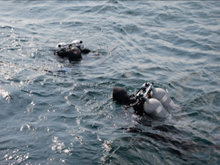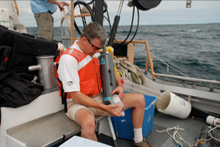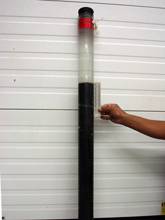Dive Studies in Middle Island Sinkhole
A benthic (lake bottome) core to be used for isotope dating. Click image for larger view and image credit.

NOAA divers Joe Hoyt and Russ Green prepare to collect groundwater and deploy chambers. Image courtesy of Thunder Bay Sinkholes 2008.
September 3, 2008
Vessel: Huron Explorer, 41-foot NOAA research vessel
Divers: Joe Hoyt and Russ Green
Scientists: Bopi Biddanda, Steve Nold, Scott Kendall
Sea conditions: 2- to 4-ft waves, strong (15 knot) breeze
Objectives:
- Quantify metabolic rates of benthic (bottom-dwelling) microbes. How fast are they photosynthesizing?
- Collect surface and groundwater samples. How are the chemical components in the waters different?
- Collect sediments to determine the lead isotopic content. How old are the sediments, and what is the rate of sediment accumulation?
- Collect benthic mat material. What is the identity and composition of the microorganisms inhabiting the sinkhole?
Field Operations:
- Deployed benthic chambers (4 light and 2 dark). These have a sonde (an oxygen detector) connected to a sealed chamber that allows light for the photosynthetic microbes (see figures).
- Collected Alcove and Arena groundwaters using Niskin bottles. These were sub-later sampled into smaller bottles.
- Divers collected long (greater than 1 meter [m]) cores for lead isotope dating (see figure).
- Divers collected purple photosynthetic mats from the Arena and white filamentous “streamers” from the Alcove.
Lab Procedures:
- Sondes were calibrated and activated before deployment.
- Water samples were filtered for dissolved carbon and nutrient analyses.
- Sediments were sectioned into thin (1 centimeter [cm]) slices and frozen for lead isotope dating.
- Mats were analyzed for gas content, microscopy was performed, and samples were preserved for analyses of pigments and medically important pharmaceutical compounds.

Steve Nold empties groundwater collected from the bottom of the Middle Island Sinkhole. Image courtesy of Thunder Bay Sinkholes 2008.
Observations:
- Benthic chambers will be retrieved in 2 days' time, so it's too early to make any observations here.
- Groundwater had substantially (10 times) higher conductivity than lake water. At 23 m depth, dissolved oxygen plummeted to 20% of surface values and dissolved ions increased substantially.
- Sediments were fluffy, suggesting rapid sediment accumulation and high organic matter content. There were bubbles in the top 30 cm, and sand was detected at greater than 1 m sediment depth. Cores became compressed during collection.
- Purple “fingers” were found on the Arena floor. These fingers were successfully retrieved by our dive team and retained their finger-shaped architecture for lab analysis.
Coming Up Next:
- Benthic chambers will be retrieved on Friday, September 5, 2008. Sonde data (continuously collected) will be analyzed to quantify benthic metabolism.
- Water samples will be taken back to our labs to analyze for nutrients and stable carbon isotope content.
- Sediments will be dated using lead isotopes (210Pb) at University of Wisconsin – Milwaukee.
- Mats will be placed in growth chambers and monitored, using time-lapse photography to detect motility of the filamentous cyanobacteria.
- Check future logs for still and video images! We'll keep looking for metazoans (tiny animals), such as nematodes and zooplankton.
Sign up for the Ocean Explorer E-mail Update List.


















